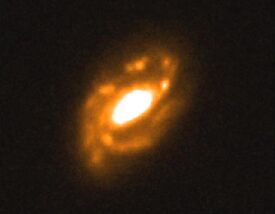Astronomy:ISOHDFS 27
From HandWiki
| ISOHDFS 27 | |
|---|---|
 ISOHDFS 27 taken by the Hubble Space Telescope | |
| Observation data (J2000 epoch) | |
| Constellation | Tucana |
| Right ascension | 22h 32m 47.7s |
| Declination | −60° 33′ 35.9″ |
| Redshift | 0.5807±0.0003 |
| Helio radial velocity | 174,090 km/s (108,170 mi/s) |
| Galactocentric velocity | 174,009 km/s (108,124 mi/s) |
| Distance | 6 billion ly (1.8 billion pc) (light travel distance) 7 billion ly (2.1 billion pc) (comoving distance) |
| Apparent magnitude (V) | 20.51 |
| Characteristics | |
| Type | Sab |
| Mass | 1.04×1012 M☉ |
| Size | 130,000 ly (40,000 pc) |
| Apparent size (V) | 0.07 × 0.07 |
| Other designations | |
| HDFS J223247.66-603335.9, LFR2003 193, SB-WF 3572-1508, CDD2000 1670, USNOA2 0225-31548819 | |
ISOHDFS 27 is a spiral galaxy in the constellation Tucana, and was discovered in the Hubble Deep Field South survey. It is the most massive spiral galaxy found in the survey,[1] measuring 130,000 light-years (40,000 parsecs) in diameter.[2] It is located approximately 6 billion light-years (1.8 billion parsecs) from Earth[2] and has a mass greater than 1000 billion times the mass of the Sun, making it about four times as massive as the Milky Way.[1]
It was once thought to be the largest spiral galaxy in the universe,[1] but it has since been dethroned by NGC 6872.[3]
See also
External links
- "Massive spiral galaxy ISOHDFS 27" by the European Southern Observatory
- ISOHDFS 27 on SIMBAD
References
- ↑ 1.0 1.1 1.2 "Most Massive Spiral Galaxy Known in the Universe". European Southern Observatory Press Release: 25. 2000-12-01. Bibcode: 2000eso..pres...25.. https://ui.adsabs.harvard.edu/abs/2000eso..pres...25..
- ↑ 2.0 2.1 information@eso.org. "Massive spiral galaxy ISOHDFS 27" (in en). https://www.eso.org/public/images/eso0041a/.
- ↑ SVS (2013-10-17). "NASA Scientific Visualization Studio | The Largest-Known Spiral Galaxy" (in english). https://svs.gsfc.nasa.gov/30111/.
 |

